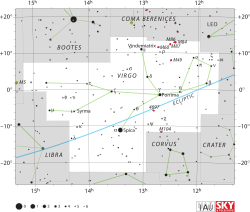Zeta Virginis
| Observation data Epoch J2000 Equinox J2000 | |
|---|---|
| Constellation | Virgo |
| Right ascension | 13h 34m 41.591s[1] |
| Declination | –00° 35′ 44.95″[1] |
| Apparent magnitude (V) | +3.376[2] |
| Characteristics | |
| Spectral type | A3 V[3] |
| U−B color index | +0.141[2] |
| B−V color index | +0.114[2] |
| Astrometry | |
| Radial velocity (Rv) | –13.2[2] km/s |
| Proper motion (μ) | RA: –280.48 ± 0.17[1] mas/yr Dec.: +49.05 ± 0.12[1] mas/yr |
| Parallax (π) | 44.03 ± 0.19 mas[1] |
| Distance | 74.1 ± 0.3 ly (22.71 ± 0.10 pc) |
| Absolute magnitude (MV) | 1.64±0.05[4] |
| Details | |
| ζ Vir A | |
| Mass | 2.041±0.024[4] M☉ |
| Radius | 2.079±0.025[5] R☉ |
| Luminosity | 17.885±0.252[5] L☉ |
| Surface gravity (log g) | 4.12 cgs |
| Temperature | 8247±52[5] K |
| Rotational velocity (v sin i) | 222[6] km/s |
| Age | 0.51[7] Gyr |
| ζ Vir B | |
| Mass | 0.168+0.012 −0.016[4] M☉ |
| Other designations | |
Zeta Virginis (ζ Vir, ζ Virginis) is a star in the zodiac constellation of Virgo. Zeta Virginis has the proper name Heze, which is of unclear origin. It is visible to the naked eye with has an apparent visual magnitude is +3.376 [2] and is located about a half degree south of the celestial equator at a distance of 74.1 light-years (22.7 parsecs) from Earth.[2]
ζ Virginis is a main sequence star with a spectral class A3 V,[5] indicating that it is generating energy through the nuclear fusion of hydrogen at its core. This energy is being radiated from its outer envelope at an effective temperature of 8,247 K,[5] giving Zeta Virginis the white hue of an A-type star.[8] It has twice the mass and double the radius of the Sun and is about a half billion years old.[5][7]
In 2010, a low mass stellar companion was discovered, ζ Virginis B. The object has not been under observation for a sufficient length of time to determine accurate orbital elements. However, the pair are estimated to be orbiting at an average separation of at least 24.9 Astronomical Units and an orbital eccentricity of 0.16 or more. Their orbital period is a minimum of 124 years. This companion may be a red dwarf star, which would explain the observed X-ray flux from this system.[4]
References
- ^ a b c d e van Leeuwen, F. (2007). "Validation of the new Hipparcos reduction". Astronomy and Astrophysics. 474 (2): 653–664. arXiv:0708.1752. Bibcode:2007A&A...474..653V. doi:10.1051/0004-6361:20078357. Vizier catalog entry
- ^ a b c d e f Hipparcos star Zeta Virginis Archived January 2, 2013, at the Wayback Machine
- ^ The stars of Virgo Alcyone Ephemeris
- ^ a b c d Hinkley, Sasha (March 2010), "Discovery and Characterization of a Faint Stellar Companion to the A3V Star ζ Virginis", The Astrophysical Journal, 712 (1): 421–428, arXiv:1002.1074, Bibcode:2010ApJ...712..421H, doi:10.1088/0004-637X/712/1/421
- ^ a b c d e f Heze (Zeta Virginis), Kaler Stars
- ^ Royer, F.; Zorec, J.; Gómez, A. E. (February 2007), "Rotational velocities of A-type stars. III. Velocity distributions", Astronomy and Astrophysics, 463 (2): 671–682, arXiv:astro-ph/0610785, Bibcode:2007A&A...463..671R, doi:10.1051/0004-6361:20065224 Data catalog: Bibcode:2006yCat..34630671R
- ^ a b Su, K. Y. L. (December 2006), "Debris Disk Evolution around A Stars", The Astrophysical Journal, 653 (1): 675–689, arXiv:astro-ph/0608563, Bibcode:2006ApJ...653..675S, doi:10.1086/508649
- ^ "The Colour of Stars", Australia Telescope, Outreach and Education, Commonwealth Scientific and Industrial Research Organisation, December 21, 2004, retrieved 2012-01-16
External links
- Boyajian, Tabetha S. et al., 2012. Stellar Diameters and Temperatures. I. Main-sequence A, F, and G Stars. The Astrophysical Journal vol 746 (1) p. 101 [1]

